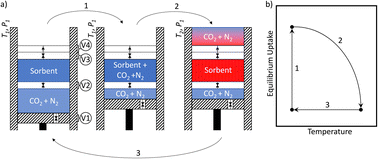How can you tell if a sorbent material will be good for any gas separation process – without having to do detailed simulations of the full process? We present new metrics to evaluate solid sorbent materials for Direct Air Capture (DAC), a particularly challenging gas separation problem, based entirely on intrinsic properties of the sorbent material. These new metrics provide a theoretical upper bound on CO2 captured per energy as well as a theoretical upper limit on the purity of the captured CO2. These metrics apply to any adsorption-refresh cycle design. The only inputs are the path adsorption-refresh cycle in terms of thermodynamic variables and the intrinsic materials properties (primarily the equilibrium uptake, and heat capacity) along that path. In this work we demonstrate the use of these metrics with the example of temperature–pressure swing refresh cycles. To apply these metrics on a set of examples, we first generated approximations of the necessary materials properties for 11 660 metal–organic framework materials (MOFs). We find that the performance of the sorbents is highly dependent on the path through thermodynamic parameter space. These metrics allow for: (1) finding the optimum materials given a particular refresh cycle, and (2) finding the optimum refresh cycles given a particular sorbent. Applying these metrics to the database of MOFs lead to the following insights: (1) start cold – the equilibrium uptake of CO2 diverges from that of N2 at lower temperatures, and (2) selectivity of CO2 vs. other gases at any one point in the cycle does not matter – what matters is the relative change in uptake along the cycle.


